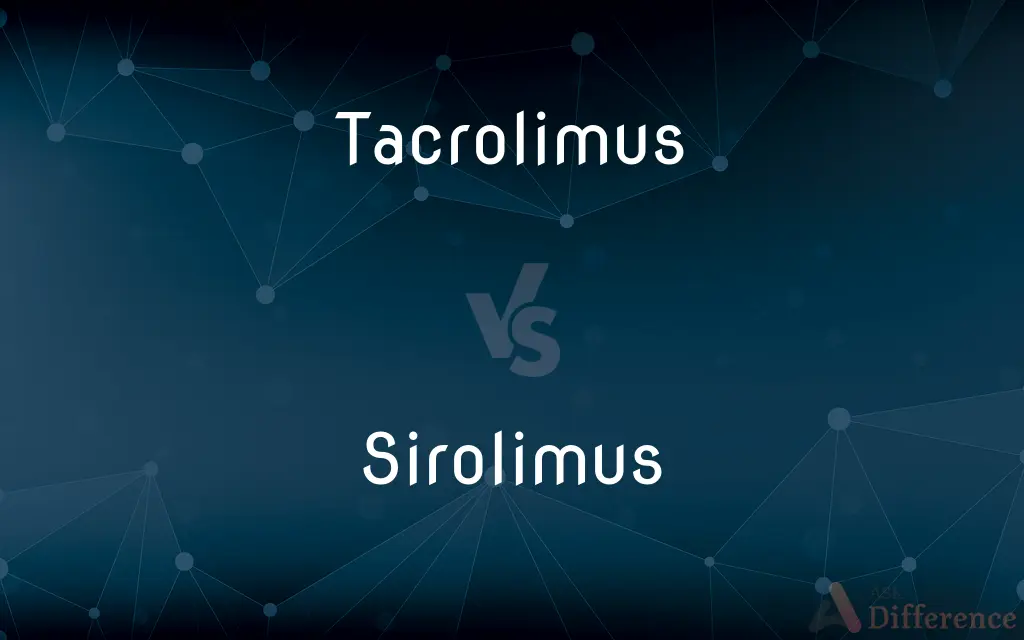Tacrolimus vs. Sirolimus — What's the Difference?
By Maham Liaqat & Urooj Arif — Updated on April 4, 2024
Tacrolimus is primarily used for organ transplant rejection prevention, focusing on inhibiting T-cell activation, whereas Sirolimus, also an immunosuppressant, targets mTOR to inhibit cell proliferation.

Difference Between Tacrolimus and Sirolimus
Table of Contents
ADVERTISEMENT
Key Differences
Tacrolimus is an immunosuppressive drug used mainly to lower the risk of organ rejection after transplantation. It achieves this by inhibiting calcineurin, which is crucial for T-cell activation. Whereas Sirolimus, also known as rapamycin, serves a similar purpose but operates differently by inhibiting the mammalian target of rapamycin (mTOR), a protein that regulates cell growth, proliferation, and survival.
Both drugs are crucial in the management of transplant patients to prevent the immune system from attacking the transplanted organ. Tacrolimus, however, is preferred for immediate post-transplant immunosuppression due to its rapid onset of action, while Sirolimus is often used for its antiproliferative effects that can be beneficial in certain long-term transplant settings.
Tacrolimus is applied topically in some instances, such as for certain skin conditions like eczema, thanks to its immunosuppressive action, which helps to reduce skin inflammation and irritation. On the other hand, Sirolimus is not used for such topical treatments, as its mode of action and side effects profile are not favorable for treating skin conditions.
The side effects of Tacrolimus can include nephrotoxicity, neurotoxicity, and increased risk of infections and cancer, reflecting its potent immunosuppressive capabilities. Sirolimus, while also carrying risks of infections and cancer, is notably associated with less nephrotoxicity, making it a preferred option for patients with renal concerns over the long term.
Despite their differences, both Tacrolimus and Sirolimus require careful monitoring of drug levels in the blood to minimize side effects and ensure therapeutic effectiveness. This aspect underscores the importance of tailored treatment and monitoring plans for patients receiving these medications.
ADVERTISEMENT
Comparison Chart
Primary Use
Prevention of organ rejection
Prevention of organ rejection
Mechanism of Action
Inhibits calcineurin to prevent T-cell activation
Inhibits mTOR to prevent cell proliferation
Onset of Action
Rapid, preferred immediately post-transplant
Slower, often used for long-term management
Application
Oral, IV, topical (for skin conditions)
Oral, not used topically
Key Side Effects
Nephrotoxicity, neurotoxicity, infections
Less nephrotoxic, but still risks infections and cancer
Compare with Definitions
Tacrolimus
Calcineurin Inhibitor.
By inhibiting calcineurin, Tacrolimus suppresses T-cell activation.
Sirolimus
MTOR Inhibitor.
Sirolimus inhibits the mTOR pathway, affecting cell growth and proliferation.
Tacrolimus
Immunosuppressant.
Tacrolimus is administered to organ transplant patients to prevent rejection.
Sirolimus
Immunosuppressant.
Sirolimus is used to prevent organ rejection, similar to Tacrolimus, but works differently.
Tacrolimus
Rapid Onset.
Tacrolimus is preferred immediately after transplantation due to its rapid effect.
Sirolimus
Long-term Management.
Due to its antiproliferative effects, Sirolimus is beneficial in the long-term management of transplant patients.
Tacrolimus
Topical Use.
Tacrolimus ointment is used for treating certain skin conditions like eczema.
Sirolimus
Side Effects.
Sirolimus users may have a lower risk of nephrotoxicity but still face risks of infections and cancer.
Tacrolimus
Side Effects.
Patients taking Tacrolimus may experience nephrotoxicity and neurotoxicity.
Sirolimus
Less Nephrotoxic.
Sirolimus is preferred for patients with renal concerns due to its lower nephrotoxicity.
Tacrolimus
Tacrolimus, sold under the brand name Prograf among others, is an immunosuppressive drug. After allogeneic organ transplant, the risk of organ rejection is moderate.
Sirolimus
Sirolimus, also known as rapamycin and sold under the brand name Rapamune among others, is a macrolide compound that is used to coat coronary stents, prevent organ transplant rejection, treat a rare lung disease called lymphangioleiomyomatosis, and treat perivascular epithelioid cell tumor (PEComa). It has immunosuppressant functions in humans and is especially useful in preventing the rejection of kidney transplants.
Tacrolimus
An immunosuppressive drug produced by the actinomycete Streptomyces tsukubaensis, C44H69NO12, used in combination with corticosteroids to prevent rejection of organ transplants.
Sirolimus
An immunosuppressive drug produced by the actinomycete Streptomyces hygroscopicus, C15H79NO13, used in combination with cyclosporine and corticosteroids to prevent rejection of transplanted tissues or organs. Also called rapamycin.
Tacrolimus
(pharmaceutical drug) An immunosuppressive drug obtained from Streptomyces tsukubaensis used mainly after organ transplantation.
Sirolimus
(pharmaceutical drug) An immunosuppressive drug C51H79NO13 that is a macrocyclic lactone obtained from a soil bacterium Streptomyces hygroscopicus and is taken orally especially to prevent rejection of transplanted organs.
Common Curiosities
What is Tacrolimus primarily used for?
Tacrolimus is primarily used to prevent organ rejection in transplant patients.
What makes Sirolimus less nephrotoxic than Tacrolimus?
Sirolimus is less nephrotoxic due to its mechanism of action, which does not involve calcineurin inhibition.
Are there any common side effects shared between Tacrolimus and Sirolimus?
Both drugs can increase the risk of infections and cancer due to their immunosuppressive effects.
Is Tacrolimus or Sirolimus preferred immediately after an organ transplant?
Tacrolimus is generally preferred immediately post-transplant due to its rapid onset of action.
Can Sirolimus be used for skin conditions?
No, Sirolimus is not typically used for topical treatment of skin conditions.
Can Tacrolimus be used topically?
Yes, Tacrolimus can be applied topically for certain skin conditions like eczema.
What differentiates Tacrolimus's and Sirolimus's use in transplant patients?
Tacrolimus is favored for immediate use post-transplant, while Sirolimus is used for its long-term benefits.
What is the significance of mTOR in Sirolimus's mechanism?
mTOR is crucial for cell proliferation and survival, which Sirolimus inhibits to exert its effects.
How does Sirolimus work to prevent organ rejection?
Sirolimus prevents organ rejection by inhibiting the mTOR pathway, which affects cell growth and proliferation.
How do Tacrolimus and Sirolimus affect the immune system?
They suppress the immune system to prevent organ rejection, though through different mechanisms.
Can both Tacrolimus and Sirolimus be taken orally?
Yes, both drugs can be administered orally.
What specific conditions are Tacrolimus ointments used for?
Tacrolimus ointments are primarily used for eczema and similar skin conditions.
How are Tacrolimus and Sirolimus monitored in patients?
Both drugs require blood level monitoring to ensure efficacy and minimize side effects.
What are the key benefits of Sirolimus in transplant management?
Its antiproliferative effects and lower nephrotoxicity are key benefits.
Why is careful monitoring necessary for patients on Tacrolimus or Sirolimus?
To minimize side effects and ensure the drugs are at therapeutic levels.
Share Your Discovery

Previous Comparison
Castration vs. Emasculation
Next Comparison
Swabia vs. BavariaAuthor Spotlight
Written by
Maham LiaqatCo-written by
Urooj ArifUrooj is a skilled content writer at Ask Difference, known for her exceptional ability to simplify complex topics into engaging and informative content. With a passion for research and a flair for clear, concise writing, she consistently delivers articles that resonate with our diverse audience.
















































